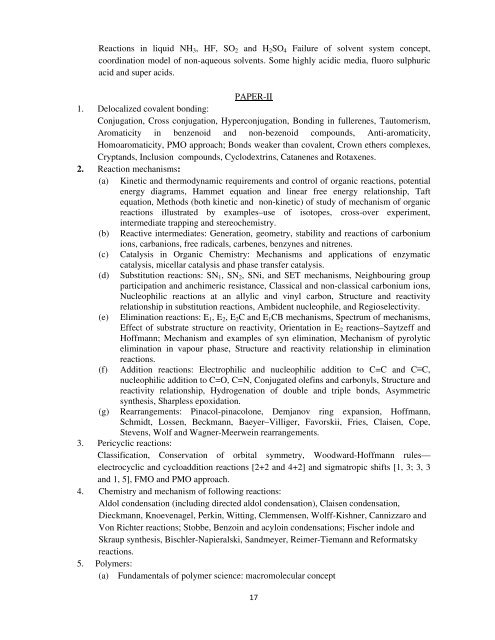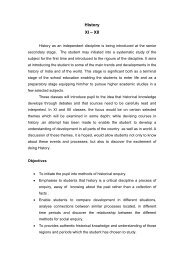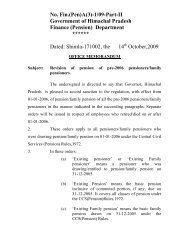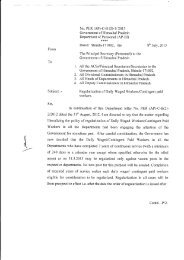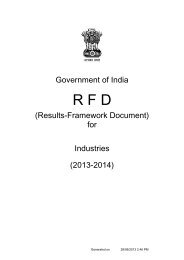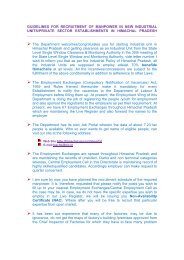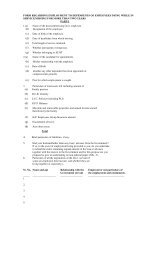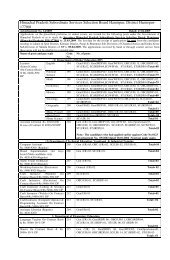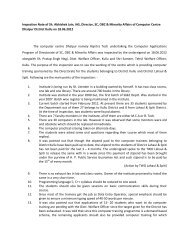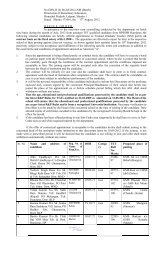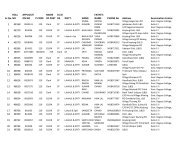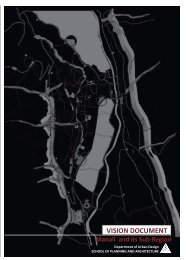Hindi - Himachal Pradesh
Hindi - Himachal Pradesh
Hindi - Himachal Pradesh
You also want an ePaper? Increase the reach of your titles
YUMPU automatically turns print PDFs into web optimized ePapers that Google loves.
Reactions in liquid NH 3 , HF, SO 2 and H 2 SO 4 Failure of solvent system concept,coordination model of non-aqueous solvents. Some highly acidic media, fluoro sulphuricacid and super acids.PAPER-II1. Delocalized covalent bonding:Conjugation, Cross conjugation, Hyperconjugation, Bonding in fullerenes, Tautomerism,Aromaticity in benzenoid and non-bezenoid compounds, Anti-aromaticity,Homoaromaticity, PMO approach; Bonds weaker than covalent, Crown ethers complexes,Cryptands, Inclusion compounds, Cyclodextrins, Catanenes and Rotaxenes.2. Reaction mechanisms:(a) Kinetic and thermodynamic requirements and control of organic reactions, potentialenergy diagrams, Hammet equation and linear free energy relationship, Taftequation, Methods (both kinetic and non-kinetic) of study of mechanism of organicreactions illustrated by examples–use of isotopes, cross-over experiment,intermediate trapping and stereochemistry.(b) Reactive intermediates: Generation, geometry, stability and reactions of carboniumions, carbanions, free radicals, carbenes, benzynes and nitrenes.(c) Catalysis in Organic Chemistry: Mechanisms and applications of enzymaticcatalysis, micellar catalysis and phase transfer catalysis.(d) Substitution reactions: SN 1 , SN 2 , SNi, and SET mechanisms, Neighbouring groupparticipation and anchimeric resistance, Classical and non-classical carbonium ions,Nucleophilic reactions at an allylic and vinyl carbon, Structure and reactivityrelationship in substitution reactions, Ambident nucleophile, and Regioselectivity.(e) Elimination reactions: E 1 , E 2 , E 2 C and E 1 CB mechanisms, Spectrum of mechanisms,Effect of substrate structure on reactivity, Orientation in E 2 reactions–Saytzeff andHoffmann; Mechanism and examples of syn elimination, Mechanism of pyrolyticelimination in vapour phase, Structure and reactivity relationship in eliminationreactions.(f) Addition reactions: Electrophilic and nucleophilic addition to C=C and CC,nucleophilic addition to C=O, C=N, Conjugated olefins and carbonyls, Structure andreactivity relationship, Hydrogenation of double and triple bonds, Asymmetricsynthesis, Sharpless epoxidation.(g) Rearrangements: Pinacol-pinacolone, Demjanov ring expansion, Hoffmann,Schmidt, Lossen, Beckmann, Baeyer–Villiger, Favorskii, Fries, Claisen, Cope,Stevens, Wolf and Wagner-Meerwein rearrangements.3. Pericyclic reactions:Classification, Conservation of orbital symmetry, Woodward-Hoffmann rules—electrocyclic and cycloaddition reactions [2+2 and 4+2] and sigmatropic shifts [1, 3; 3, 3and 1, 5], FMO and PMO approach.4. Chemistry and mechanism of following reactions:Aldol condensation (including directed aldol condensation), Claisen condensation,Dieckmann, Knoevenagel, Perkin, Witting, Clemmensen, Wolff-Kishner, Cannizzaro andVon Richter reactions; Stobbe, Benzoin and acyloin condensations; Fischer indole andSkraup synthesis, Bischler-Napieralski, Sandmeyer, Reimer-Tiemann and Reformatskyreactions.5. Polymers:(a) Fundamentals of polymer science: macromolecular concept


